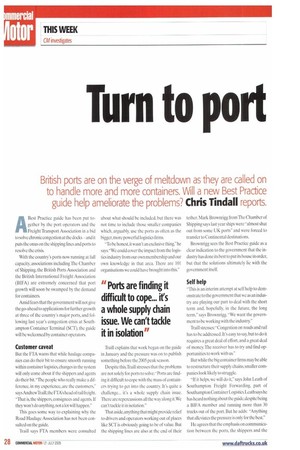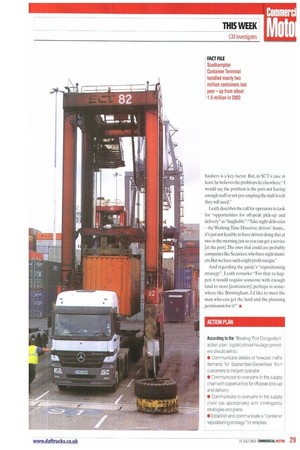Turn to pod
Page 28

Page 29

If you've noticed an error in this article please click here to report it so we can fix it.
British ports are on the verge of meltdown as they are called on to handle more and more containers. Will a new Best Practice guide help ameliorate the problems? Chris Tindall reports.
ABest Practice guide has been put together by the port operators and the Freight Transport Association in a bid to solve chronic congestion at the docks and it puts the onus on the shipping lines and ports to resolve the crisis.
With the country's ports now running at full capacity, associations including The Chamber of Shipping, the British Ports Association and the British International Freight Association (BIFA) are extremely concerned that port growth will soon be swamped by the demand for containers.
Amid fears that the government will not give the go-ahead to applications for further growth at three of the country's major ports, and following last year's congestion crisis at Southampton Container Terminal (SCT), the guide will be welcomed by container operators.
Customer caveat
But the FTA warns that while haulage companies can do their hit to ensure smooth running within container logistics, changes in the system will only conic about if the shippers and agents do their hit. "The people who really make a difference, in my experience, are the customers," saysAndrewTraill,the FI'A's head of rail freight. "That is, the shippers, consignees and agents. If they won't do anything,not a lot will happen."
This goes some way to explaining why the Road Haulage Association has not been consulted on the guide.
Train says FTA members were consulted about what should be included, but there was not time to include those smaller companies which, arguably, use the ports as often as the bigger, more powerful logistics firms.
"To be honest,it wasn't an exclusive thing." he says.-We could cover the impact from the logistics industry from our own membership and our own knowledge in that area. There are 101 organisations we could have brought into this."
Trail' explains that work began on the guide in January and the pressure was on to publish something before the 2005 peak season.
Despite this,Traill stresses that the problems are not solely for ports to solve: Ports are finding it difficult to cope with the mass of containers trying to get into the country. It's quite a challenge... it's a whole supply chain issue. There are repercussions all the way along it.We can't tackle it in isolation."
That aside, anything that might provide relief to drivers and operators working out of places like SC!' is obviously going to be of value. But the shipping lines are also at the end of their tether. Mark Brownrigg from The Chamber of Shipping says last year ships were -almost shut out from some UK ports" and were forced to transfer to Continental destinations.
Brownrigg sees the Best Practice guide as a clear indication to the government that the industry has done its best to put its house in order, but that the solutions ultimately lie with the government itself.
Self help
"This is an interim attempt at self help to demonstrate to the government that we as an industry are playing our part to deal with the short term and, hopefully, in the future, the long term," says Brownrigg. "We want the government to be working with the industry."
Traill stresses: "Congestion on roads and rail has to be addressed. It's easy to say, but to do it requires a great deal of effort, and a great deal of money. The receiver has to try and find opportunities to work with us."
But while the big container firms may be able to restructure their supply chains, smaller companies look likely to struggle.
"If it helps, we will do it," says John Leath of Southampton Freight Forwarding, part of Southampton Container Logistics. Leath says he has heard nothing about the guide,despite being a BIFA member and running more than 30 trucks out of the port. But he adds: "Anything that alleviates the pressure is only for the best."
He agrees that the emphasis on communication between the ports, the shippers and the hauliers is a key factor, But, in SCI's case at least, he believes the problems lie elsewhere:"I would say the problem is the port not having enough staff or not pre-empting the stall levels they will need."
Leath describes the call for operators to look for "opportunities for off-peak pick-up and delivery" as "laughable": "Take night deliveries — the Working Time Directive, drivers' hours... it's just not feasible to have drivers doing that at two in the morning just so you can get a service [at the port].The ones that could are probably companies like Securicor,who have night shunters.But we have such a tight profit margin."
And regarding the guide's "repositioning strategy", Leath remarks: "For that to happen it would require someone with enough land to store [containers]: perhaps in somewhere like Birmingham. I'd like to meet the man who can get the land and the planning permission for it!" • ACTION PLAN According to the "Beating Port Congestion" action plan, logistics/road haulage providers should aim to:
• Communicate details of forecast traffic demand for September-December from customers to the port operator • Communicate to everyone in the supply chain with opportunities for off-peak pick-up and delivery • Communicate to everyone in the supply chain (as appropriate) with contingency strategies and plans • Establish and communicate a "container repositioning strategy" for empties


































































































































































































